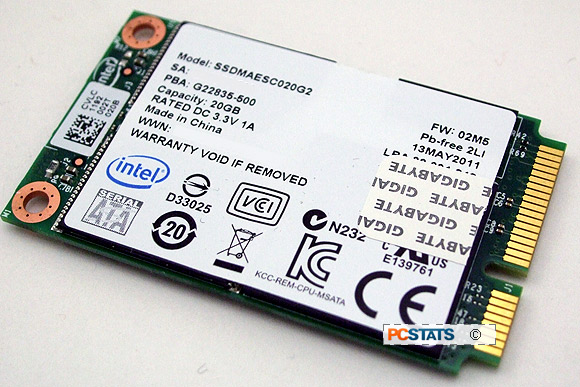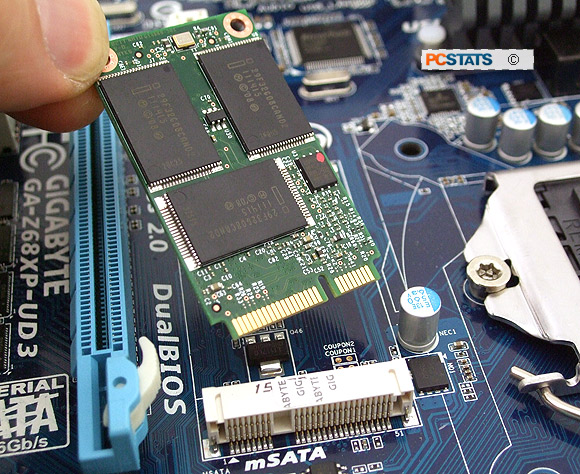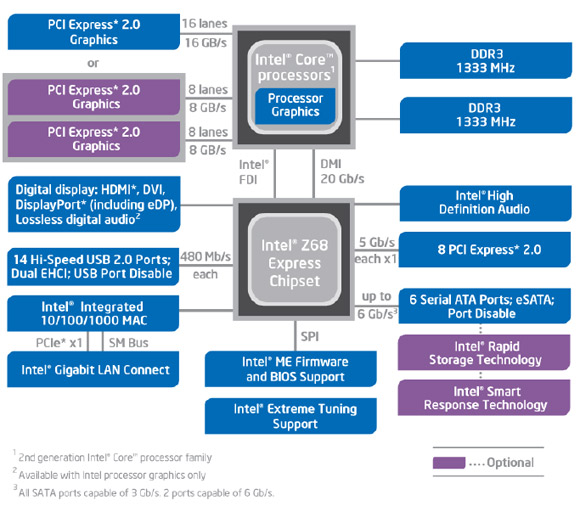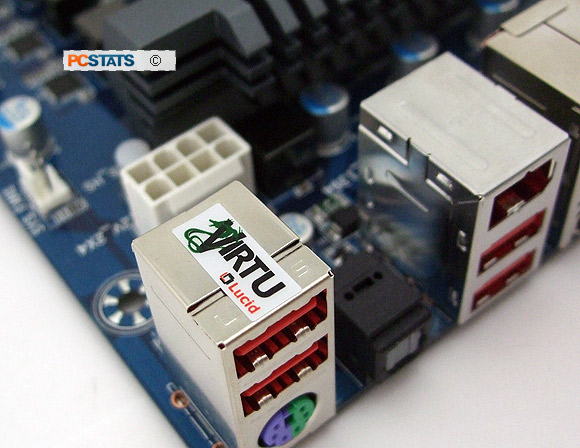
|
There are four key features that make the Gigabyte GA-Z68XP-UD3-iSSD a real killer among Intel Z68 motherboards - a bundled 20GB Intel mSATA SSD, Virtu, SLI/Crossfire and onboard HDMI video output.
95% Rating: 
|
|
|
|
Home >
Reviews >
Motherboards >
Gigabyte GA-Z68XP-UD3-iSSD |
|
|
Bundled-in 20GB SSD - Intel Smart Response Technology
 Everyone knows the main selling point of Solid State
Drives isn't storage capacity, it's speed. Mechanical hard
drives on the other hand are comparatively slow, yet vastly superior when
it comes down to cost per Terabyte. Intel Smart Response Technology seeks
to bridge these two qualities - SSD speed and HDD capacity - by intelligently storing frequently accessed hard
drive I/O data blocks to the SSD while everything else goes to the primary HDD.
With this selective approach, an affordable 20GB or 40GB SSD is sufficient to
cache frequent data. Everyone knows the main selling point of Solid State
Drives isn't storage capacity, it's speed. Mechanical hard
drives on the other hand are comparatively slow, yet vastly superior when
it comes down to cost per Terabyte. Intel Smart Response Technology seeks
to bridge these two qualities - SSD speed and HDD capacity - by intelligently storing frequently accessed hard
drive I/O data blocks to the SSD while everything else goes to the primary HDD.
With this selective approach, an affordable 20GB or 40GB SSD is sufficient to
cache frequent data.
Intel SRT is a specific feature of the Intel
Z68 chipset and for the best results it does require a fresh
installation of Windows 7 or Vista. Once enabled though, the HDD
and SSD are tied together in a sort of 'RAID 0' arrangement where
by Windows retrieves its frequent data from the SSD rather than
waiting for the HDD. There's no denying the "like-SSD responsiveness"
in data access limited situations and applications is a welcome boost,
generally to about 4/5ths the level of a pure SSD environment.
|

Intel SSDMAESC020G2 SSD (mSATA format) bundled in with the
motherboard.
|
The system is compatible with mSATA and standard SATA SSD
devices, on the GA-Z68XP-UD3-iSSD motherboard Gigabyte has added a mSATA slot
and a 20GB Intel 311 'Larson Creek' Solid State Drive. mSATA modules take up
less space and cost less than 2.5" SSDs which is why Gigabyte went this path
when opting to bundle a SSD in with this board.
The Intel SSDMAESC020G2 SSD uses a mini-PCIe
interface to connect directly to the board over the SATA 3GB/s data bus, in case
you wondered.
|

20GB of 34nm SLC Compute NAND
flash memory
|
There are a few caveats to implementing Intel SRT, but otherwise it's really easy to use and
provides tangible benefits as you'll see in the benchmarks momentarily. For an
in-depth look at Intel SRT, check out this PCSTATS Guide. Intel Z68 Express
Chipset
>Intel's Z68 Platform Controller Hub has a nearly identical feature
set to the Intel P67 and H67 chipsets that came before it, so if you're
familiar with these chipsets you'll know what to expect here. Looking
at the block diagram below we can see that the Intel Z68 PCH
communicates with socket LGA1155 processors over a DMI link at
20Gb/s and hosts eight PCI Express 2.0 lanes running at 5Gb/s. The
remaining 16 PCI Express 2.0 lanes are allocated by the processor itself
for 16GB/s total bandwidth.

As
with the Intel H67 chipset that preceded it, the Intel Z68 chipset connects
to the integrated graphics core built into every Socket 1155 'SandyBridge' microprocess
via Intel's Flexible Display Interface (FDI). This is also the main difference between
the preceding Intel P67 chipset and the Z68; Sandybridge's
integrated graphics core is now accessible for everyday work and for
specialized video transcoding acceleration via Intel Quick Sync, in addition to
the overclocking capabilities that were inherent to the Intel P67 chipset.
With the integrated graphics core we can, for example, transcode a 450MB
1080i high definition MPEG2 video via Cyberlink MediaShow Espresso 6 to a
640x360 MP4 video in about 14 seconds! Without Intel's HD 3000 IGP, the
same task takes nearly 50 seconds. Keep in mind that not all Intel Z68
boards come with video outputs (ie. the Gigabyte GA-Z68X-UD5-B3), but many boards that do also support
LucidLogix Virtu which enables users to virtualize the Intel HD 3000/2000
graphics through a discreet videocard and have the best of both discrete and
integrated graphics worlds.
| Intel Chipset Feature
Comparison |
|
Intel Z68 Express |
Intel P67
Express |
Intel H67
Express |
Intel X58
Express |
| CPU |
LGA 1155
Core i5/i7 2nd Gen. |
LGA 1155
Core i5/i7 2nd Gen. |
LGA 1155
Core i5/i7 2nd Gen. |
LGA 1366
Core i7 |
| Chipset Code Name |
Couger Point (65nm) |
Couger Point (65nm) |
Couger Point (65nm) |
Tylersburg (65nm) |
| Bus Interface / Speed |
DMI 20Gb/s |
DMI 20Gb/s |
DMI 20Gb/s |
QPI 25.6Gb/s |
| Memory Support |
DDR3-1333, dual channel |
DDR3-1333, dual channel |
DDR3-1333, dual channel |
DDR3 1066, triple channel |
| Maximum Memory Capacity |
32GB (64-bit) |
32GB (64-bit) |
32GB (64-bit) |
24GB (64-bit) |
| Integrated Graphics |
Yes. via CPU |
- |
Yes. via CPU |
- |
| Integrated Graphics Ports |
HDMI, DVI, DP, VGA |
- |
HDMI, DVI, DP, VGA |
- |
| PCI Express 2.0 Lanes |
8 |
8 |
8 |
36 |
| PCI Express x1 Lanes |
0 |
0 |
0 |
6 |
| Intel Rapid Storage Technology |
Yes |
Yes |
Yes |
Yes |
| Intel Smart Response Technology |
Yes |
- |
- |
- |
| SATA 6Gb/s | SATA 3Gb/s | IDE Ports |
2/4/0 |
2/4/0 |
2/4/0 |
0/6/0 |
| RAID |
0, 1, 5, 10 |
0, 1, 5, 10 |
0, 1, 5, 10 |
0, 1, 5, 10 (via ICH10R) |
| Intelgrated LAN |
10/100/1000 MAC |
10/100/1000 MAC |
10/100/1000 MAC |
- |
| USB 3.0 Ports |
0 |
0 |
0 |
0 |
| USB 2.0 Ports |
14 |
14 |
14 |
12 |
| PCI Masters |
0 |
0 |
0 |
6 |
| Intel High Definition
Audio |
Yes |
Yes |
Yes |
Yes | | |
Lucid Logix Virtu
LucidLogix
Virtu is a software driver Intel validated for the Intel Z68 platform that
enables on-the-fly switching between discreet graphics cards and Sandy Bridge's
integrated Intel HD3000/2000 graphics core by virtualizing one or the other. If
the monitor is connected to the GA-Z68XP-UD3-iSSD's onboard HDMI video output,
Virtu virtualizes the discreet videocard (i-Mode) when 3D games are launched.
Conversely, if the monitor is connected to a discrete videocard Virtu
virtualizes the IGP when required (d-Mode).
|

GA-Z68XP-UD3-iSSD motherboard is validated for Lucid's
VIRTU driver.
|
The key to
Virtu is that it allows the HD 3000/2000 IGP to accelerate video transcoding
tasks via Intel QuickSync and seamlessly switch to purpose bred discreet
videocards when 3D gaming.

Moving along, it's time for a 360-degree look at the
Gigabyte GA-Z68XP-UD3-iSSD motherboard.
|
